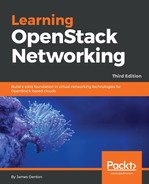This chapter saw us installing and configuring the Neutron Open vSwitch mechanism driver and agent on two compute nodes and a dedicated network node, which will be used for distributed virtual routing functions at a later time. Instances scheduled to compute02 and compute03 will leverage Open vSwitch virtual network components, while compute01 and network services on controller01 will leverage Linux bridges.
Both the Linux bridge and Open vSwitch drivers and agents for Neutron provide unique solutions to the same problem of connecting virtual machine instances to the network. The use of Open vSwitch relies on flow rules to determine how traffic in and out of the environment should be processed and requires both user space utilities and kernel modules to perform such actions. On the other hand, the use of Linux bridges requires the 8021q and bridge kernel modules and relies on the use of VLAN and VXLAN interfaces on the host to bridge instances to the physical network.For simple environments, I recommend using the ML2 plugin and Linux bridge mechanism driver and agent, unless integration with OpenFlow controllers or the use of a third-party solution or plugin is required. Other Neutron technologies, such as distributed virtual routers, are only available when using the Open vSwitch driver and agent.
In the next chapter, you will be guided through the process of creating different types of networks to provide connectivity to instances. The process of creating networks is the same for both Linux bridge and Open vSwitch-based environments, but the underlying network implementation will vary based on the driver and agent in use.
